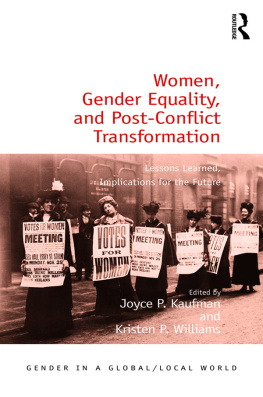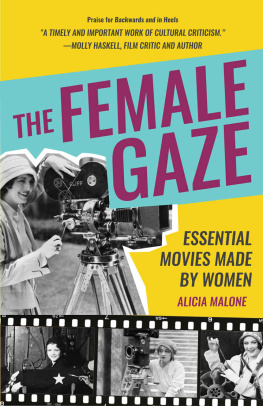THE WAR OF THE
SEXES
How Conflict and Cooperation Have Shaped
Men and Women from Prehistory to the Present

PAUL SEABRIGHT
PRINCETON UNIVERSITY PRESS
Princeton and Oxford
Copyright 2012 by Princeton University Press
Published by Princeton University Press, 41 William Street, Princeton, New Jersey 08540 In the United Kingdom: Princeton University Press, 6 Oxford Street, Woodstock, Oxfordshire OX20 1TW
press.princeton.edu
Jacket photograph: Bride and groom figurines on cake top back to back.
Photographer: John Slater. Courtesy of Getty Images.
Excerpts from Poems of Love and War: From the Eight Anthologies and
the Ten Long Poems of Classical Tamil , translated by A. K. Ramanujan,
copyright 1985 Columbia University Press. Reprinted with permission
of the publisher.
Excerpt from Reflection from Anita Loos, by William Empson,
copyright 1940 William Empson, reprinted by permission of
Curtis Brown, Ltd.
All Rights Reserved
Library of Congress Cataloging-in-Publication Data
Seabright, Paul.
The war of the sexes : how conflict and cooperation have shaped men and women from prehistory to the present / Paul Seabright.
p. cm.
Includes bibliographical references and index.
ISBN 978-0-691-13301-0 (hbk. : alk. paper)
1. Sex (Psychology). 2. Sex differences (Psychology). 3. Interpersonal relations. 4. MenPsychology. 5. WomenPsychology. I. Title.
BF692.S345 2012
306.709dc23
2011053122
British Library Cataloging-in-Publication Data is available
This book has been composed in Minion with Knockout display by Princeton Editorial Associates Inc., Scottsdale, Arizona
Printed on acid-free paper.
Printed in the United States of America
10 9 8 7 6 5 4 3 2 1
For Isabelle
CONTENTS
ACKNOWLEDGMENTS
A
BOOK LIKE THIS IS THE FRUIT of a great deal of teamwork. I am grateful to many people who have contributed time, energy, and expertise to sharpen the argument, unclog the prose, and remove some of the many errors in earlier drafts. The following made valuable comments on part or all of the manuscript: Terri Apter, Nicoletta Berardi, Giuseppe Bertola, Sam Bowles, Brian Boyd, Wendy Carlin, Ananish Chaudhuri, Tyler Cowen, Isabelle Daudy, Roberta Dessi, Anna Dreber-Almenberg, Jeremy Edwards, Rosalind English, John Fingleton, Guido Friebel, Muna Genikis, Ricardo Guzmn, Geoff Hawthorn, Peregrine Horden, Marie Lalanne, Maike Lentner, Eunate Mayor, Patricia Morison, Danielle Nolles, Alice Seabright, Diana Seabright, Edmond Seabright, Jack Seabright, Luke Seabright, Laura Spinney, Kim Sterelny, Charmaine Tan, Geeraj Vermeij, and Marie-Claire Villeval. The responsibility for any remaining errors is entirely my own.
Camille Boudot, Katie Brewis, Sebastian Kohls, and Adeline Lo provided outstanding research assistance. Alison Booth, Will Dawkins, Paul Hooper, and Johanna Rickne gave helpful advice and information on particular questions.
Nicoletta Berardi, Samuele Centorrino, Elodie Djemai, Guido Friebel, Astrid Hopfensitz, Marie Lalanne, and Manfred Milinski have been stimulating and tolerant coauthors of research papers reported in the book. Among my other coauthors, Wendy Carlin, John Fingleton, Geoff Hawthorn, Thierry Magnac, Alice Mesnard, Bob Rowthorn, Mark Schaffer, and Fiona Scott-Morton have left an important mark on the way I think about the issues considered here. I have learned much on these topics from conversations (sometimes over many years) with Bina Agarwal, Sam Bowles, Rob Boyd, Geoff Brennan, Jung-Kyoo Choi, Partha Dasgupta, Jeremy Edwards, Ernst Fehr, Ben Fraser, Pauline Grosjean, Angie Hobbs, Paul Hooper, Hillard Kaplan, Willemien Kets, Jacques Le Pottier, Sheilagh Ogilvie, Ugo Pagano, Linda Partridge, Richard Portes, Carlos Rodriguez-Sickert, Suzanne Scotch-mer, Claudia Senik, Kim Sterelny, and Libby Wood.
Two places have been particularly important in giving me the physical and intellectual conditions that made it possible to do this work. The Toulouse School of Economics, where I have now been based for a little over ten years (though it did not always go by that name), has been a superb environment for research, teaching, and the enjoyment of life; my debts to friends and colleagues there are too numerous to list individually. The Santa Fe Institute, at whose Behavioral Sciences Program I have been an almost-annual guest for the last seven years, is a wonderful place to meet scholars from many disciplines; every visit has been the occasion for new and sometimes quite unexpected discoveries.
Preliminary (sometimes too preliminary) versions of the ideas developed in this book were presented to audiences at the Royal Economic Society Annual Lecture in 2005; the European Economic Association's twentieth anniversary session The Economics of the Human Animal in 2006; the Hooker Visiting Lecture at McMaster University in 2006; the BBVA Annual Lecture 2006; the Darwin Lectures for the Darwin Anniversary in 2009 at Darwin College, Cambridge; and the Institute of Economic Growth Distinguished Lecture in New Delhi in 2011. I learned much from audience reaction on these occasions and would like to thank Bina Agarwal, William Brown, Richard Portes, John Sutton, Jaume Ventura, and Xavier Vives for the invitations. I am also grateful for the many valuable comments from seminar audiences to whom I have presented research material on these topics in Auckland, Canberra, Hong Kong, New Delhi, Norwich, Oxford, Santiago, Stockholm, and Toulouse.
My friend and agent Catherine Clarke has been, for this project as for others, an unfailing source of support and shrewd advice. My editor at Princeton, Seth Ditchikas well as Peter Dougherty, with whom my contacts go back at least a decadehave managed to combine friendly encouragement with absolute rigor. Terri O'Prey steered the book through production with the support and professionalism of Peter Strupp and his colleagues at Princeton Editorial Associates. My thanks to them all.
In addition to those mentioned above, I am indebted in a variety of ways to Emmanuelle Auriol, Jacques Barrat, David Begg, Gloria Carnevali, Grard Caz, Nathalie Caz, Sabrina Choudar, Jenny Corbett, Diane Coyle, Jacques Crmer, Christiane Fioupou, Marie-Pierre Flandy, Mireille Gealageas, Susan Greenfield, David Hart, Susan Hurley, Jacqueline Hylkema, Marc Ivaldi, Priscille Lachat-Sarrete, Jean-Jacques Laffont, Alena Ledeneva, Claudine Leduc, Jean Leduc, Jibirila Leinyuy, Michael Morgan, Damien Neven, Rory O'Connor, Nick Rawlins, Stephanie Renard, Andrew Schuller, Kay Sexton, Jean Tirole, Anne Vanhems, and Charlotte Wang for advice, encouragement, friendship, and inspiration. In small and large ways, without them the book would have been a different one.
My parents, Jack and Diana Seabright, encouraged my very first projects and continue to encourage them to this day. My children, Alice, Edmond, and Luke Seabright, have been an unfailing source of ideas as well as a formidable skeptical barrier for my own arguments to pass. Their mother, Isabelle Daudy, has never lost faith in the power of lucid discussion over domestic conflicts of interest or in the compatibility of reason and love. This book is dedicated to her.
PART ONE
PREHISTORY
ONE
Introduction
En notre vie mortelle il n'est d'autre vrit que le chevauchement, tout le restant n'tant que lanternes et fariboles.
(Our mortal life is nothing but coupling; all the rest is just lanterns and nonsense.)
Albert Cohen, Belle du Seigneur , 1968
Cooperation and Conflict
A
FEW MILES WEST OF CHICAGO, on a warm night in late spring, a fast and fancy courtship is playing out in full view of some admiring bystanders. He's lithe and he's loaded, and she's had her eye on him since the moment he swung into view. The admiration is clearly mutual: he's invited her to join him for a meal, with a sparkle in the eye that suggests he's looking for something in return and that he doesn't expect to receive no for an answer. Her charms are unmistakable: her voluptuous curves single her out unmissably in his eyes from the gaggle of her girlfriends fluttering excitedly about on their night out. It looks at first glance as though they understand each other perfectly, this playful couple. But in fact there's a lot they don't know about each other, things that might surprise them if they did. She doesn't realize that he's much less rich than he looks. And he doesn't realize that she's had herself cosmetically enhanced: those curves aren't as authentic as he thinks they are. He has no idea just how many of her girlfriends have done the same. And if he were capable of giving the matter a moment's thought, he might be a little put out to realize that the admiration they all share for his attributes has everything to do with his offer of dinner and nothing at all to do with his physique. He may be in it for the pleasure, but she is only too aware that it's also a business deal. She's not a gold digger exactly, but she has a shrewd head on her shoulders.












